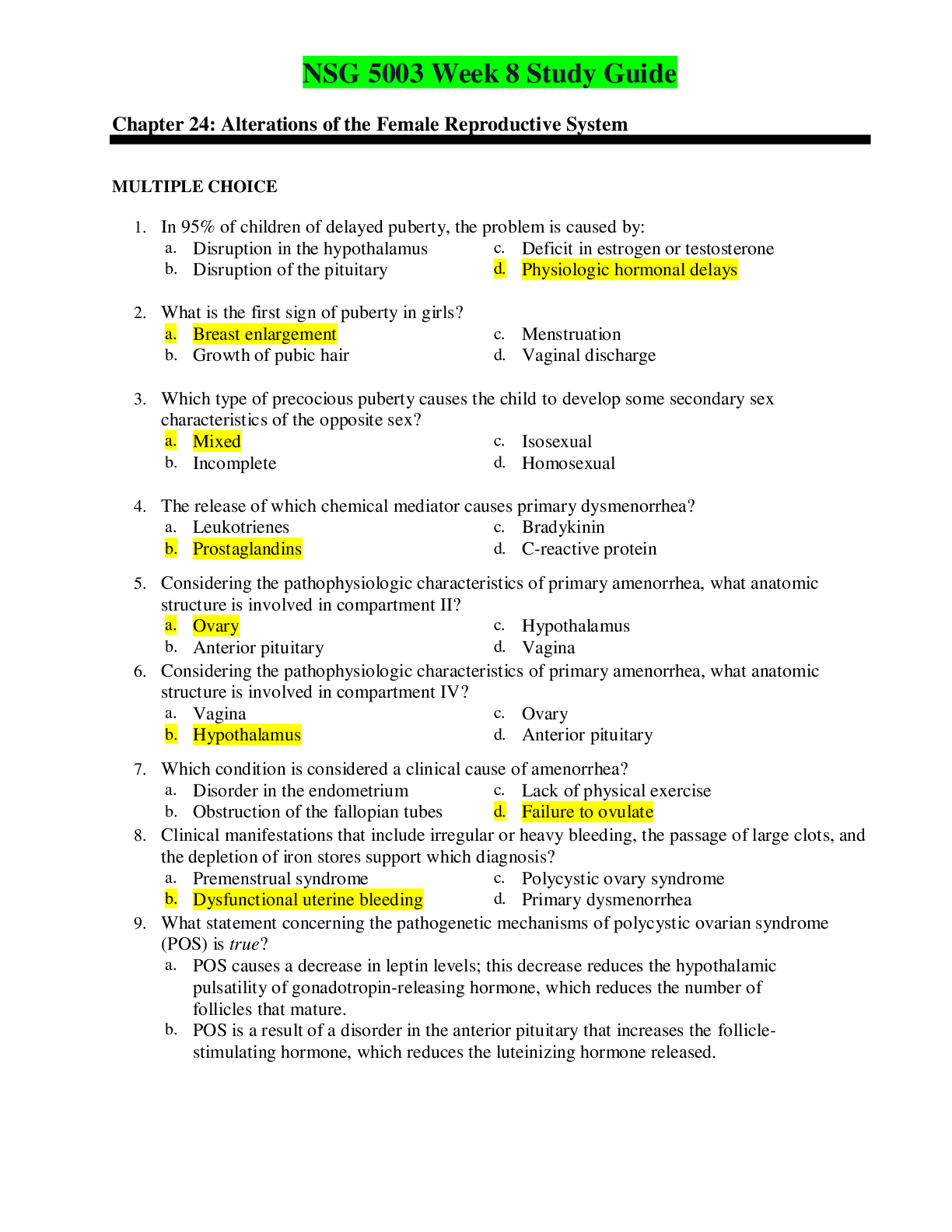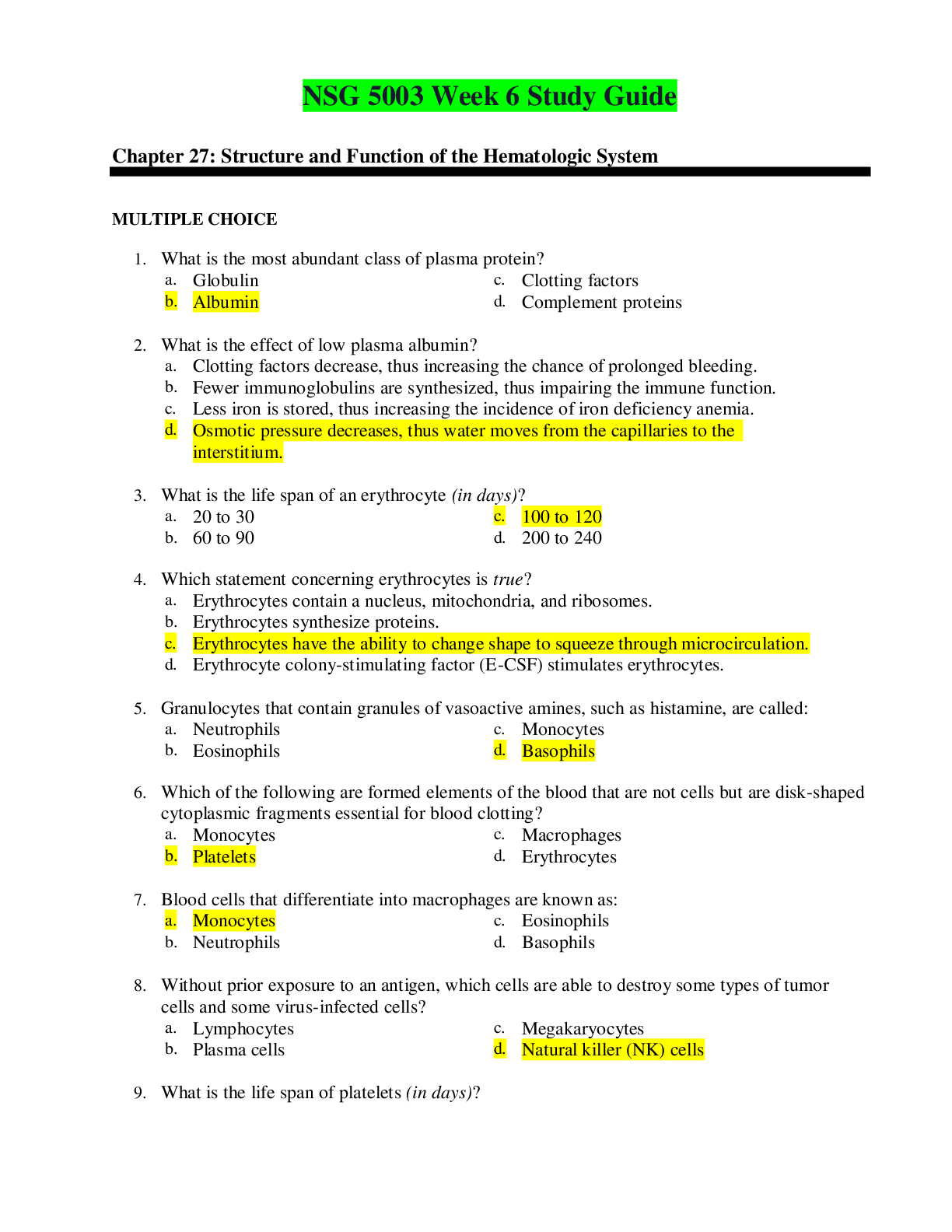*NURSING > STUDY GUIDE > NSG 5003 Week 2 Study Guide - Chapter 7 - 11 (All)
NSG 5003 Week 2 Study Guide - Chapter 7 - 11
Document Content and Description Below
NSG 5003 Week 2 Study Guide Chapter 7: Innate Immunity: Inflammation MULTIPLE CHOICE 1. Which action is a purpose of the inflammatory process? 2. How do surfactant proteins A through D... provide innate resistance? 3. Which secretion is a first line of defense against pathogen invasion that involves antibacterial and antifungal fatty acids, as well as lactic acid? 4. Which bacterium grows in the intestines after prolonged antibiotic therapy? 5. What causes the edema that occurs during the inflammatory process? 6. What process causes heat and redness to occur during the inflammatory process? 7. Activation of the classical pathway begins with: 8. What plasma protein system forms a fibrinous meshwork at an inflamed site? 9. Which component of the plasma protein system tags pathogenic microorganisms for destruction by neutrophils and macrophages? 10. What is the vascular effect of histamine released from mast cells? 11. What is an outcome of the complement cascade? 12. The function of opsonization related to the complement cascade is to: 13. In the coagulation (clotting) cascade, the intrinsic and the extrinsic pathways converge at which factor? 14. Which chemical interacts among all plasma protein systems by degrading blood clots, activating complement, and activating the Hageman factor? 15. The chemotactic factor affects the inflammatory process by: 16. What affect does the process of histamine binding to the histamine-2 (H2) receptor have on inflammation? 17. Frequently when H1 and H2 receptors are located on the same cells, they act in what fashion? 18. Some older adults have impaired inflammation and wound healing because of which problem? 19. Which chemical mediator derived from mast cells retracts endothelial cells to increase vascular permeability and to cause leukocyte adhesion to endothelial cells? 20. What is the inflammatory effect of nitric oxide (NO)? 21. What is the correct sequence in phagocytosis? 22. When considering white blood cell differentials, acute inflammatory reactions are related to elevations of which leukocyte? 23. In the later stages of an inflammatory response, which phagocytic cell is predominant? 24. In regulating vascular mediators released from mast cells, the role of eosinophils is to release: 25. What is the role of a natural killer (NK) cells? 26. Which cytokine is produced and released from virally infected host cells? 27. IFN- is secreted from which cells? 28. Which manifestation of inflammation is systemic? 29. The acute inflammatory response is characterized by fever that is produced by the hypothalamus being affected by: 30. What occurs during the process of repair after tissue damage? 31. The role of fibroblasts during the reconstructive phase of wound healing is to: 32. A keloid is the result of which dysfunctional wound healing response? 33. Which solution is best to use when cleaning a wound that is healing by epithelialization? 34. Many neonates have a transient depressed inflammatory response as a result of which condition? 35. During phagocytosis, what is occurring during the step referred to as opsonization? 36. Fusion is the step in phagocytosis during which: 37. During the process of endocytosis, the phagosome step results in: 38. When cellular damage occurs and regeneration is minor with no significant complications, the process of returning the cells to preinjury function is referred to as: 39. Newborns often have deficiencies in collectin-like proteins, making them more susceptible to what type of infection? 40. Which cell is the body’s primary defense against parasite invasion? Chapter 8: Adaptive Immunity MULTIPLE CHOICE 1. Which primary characteristic is unique for the immune response? 2. In which structure does B lymphocytes mature and undergo changes that commit them to becoming B cells? 3. What is the term for the process during which lymphoid stem cells migrate and change into either immunocompetent T cells or immunocompetent B cells? 4. Which type of immunity is produced by an individual after either natural exposure to the antigen or after immunization against the antigen? 5. What type of immunity is produced when an immunoglobulin crosses the placenta? 6. The portion of the antigen that is configured for recognition and binding is referred to as what type of determinant? 7. Which characteristic is the most important determinant of immunogenicity when considering the antigen? 8. When antigens are administered to produce immunity, why are different routes of administration considered? 9. The functions of the major histocompatibility complex (MHC) and CD1 molecules are alike because both: 10. Where are antibodies produced? a. Helper T lymphocytes c. Plasma cells b. Thymus gland d. Bone marrow 11. Which immunoglobulin is present in blood, saliva, breast milk, and respiratory secretions? 12. Which antibody initially indicates a typical primary immune response? 13. An individual is more susceptible to infections of mucous membranes when he or she has a seriously low level of which immunoglobulin antibody? 14. The B-cell receptor (BCR) complex functions uniquely by: 15. The generation of clonal diversity occurs primarily during which phase of life? 16. The generation of clonal diversity includes a process that: 17. Which statement is true concerning clonal selection? 18. Which is an example of an endogenous antigen? 19. Which cytokine is needed for the maturation of a functional helper T cell? 20. Th2 cells produce IL-4 and suppress which cells? 21. Which statement is believed to be true concerning Th1 cells? 22. Which statement is believed to be true concerning Th2 cells? 23. When a person is exposed to most antigens, antibodies can be usually detected in his or her circulation within: 24. Vaccinations are able to provide protection against certain microorganisms because of the: 25. Why is the herpes virus inaccessible to antibodies after the initial infection? 26. Increased age may cause which change in lymphocyte function? 27. How do antibodies protect the host from bacterial toxins? 28. Which T cell controls or limits the immune response to protect the host’s own tissues against an autoimmune response? 29. Evaluation of umbilical cord blood can confirm that which immunoglobulin level is near adult levels? 30. Which statement is true concerning the IgM? 31. Which cell has the ability to recognize antigens presented by the MHC class I molecules? 32. Which cell has a role in developing cell-mediated immunity? 33. How does the aging process of the T-cell activity affect older adults? 34. Which statement is true regarding maternal antibodies provided to the neonate? 35. Antibodies that are associated with mucosal immune system, such as immunoglobulins, function to prevent which type of infections? 36. Cytokines are vital to a cell’s ability to do which function? Chapter 9: Alterations in Immunity and Inflammation MULTIPLE CHOICE 1. Hypersensitivity is best defined as a(an): 2. A hypersensitivity reaction that produces an allergic response is called: 3. The common hay fever allergy is expressed through a reaction that is mediated by which class of immunoglobulins? 4. Which type of antibody is involved in type I hypersensitivity reaction? 5. Blood transfusion reactions are an example of: 6. During an IgE-mediated hypersensitivity reaction, which leukocyte is activated? 7. During an IgE-mediated hypersensitivity reaction, what causes bronchospasm? 8. During an IgE-mediated hypersensitivity reaction, the degranulation of mast cells is a result of which receptor action? 9. What characteristic do atopic individuals have that make them genetically predisposed to develop allergies? 10. What is the mechanism that results in type II hypersensitivity reactions? 11. When mismatched blood is administered causing an ABO incompatibility, the erythrocytes are destroyed by: 12. When antibodies are formed against red blood cell antigens of the Rh system, the blood cells are destroyed by: 13. When soluble antigens from infectious agents enter circulation, tissue damage is a result of: 14. How are target cells destroyed in a type II hypersensitivity reaction? 15. Graves disease (hyperthyroidism) is an example of which type II hypersensitivity reaction? 1 REF: Page 267 | Page 269 16. Type III hypersensitivity reactions are a result of which of the following? 17. A type IV hypersensitivity reaction causes which result? 18. In a type III hypersensitivity reaction, the harmful effects after the immune complexes that are deposited in tissues are a result of: 19. Raynaud phenomenon is classified as a type III hypersensitivity reaction and is due to: 20. Deficiencies in which element can produce depression of both B- and T-cell function? 21. When the maternal immune system becomes sensitized against antigens expressed by the fetus, what reaction occurs? 22. Tissue damage caused by the deposition of circulating immune complexes containing an antibody against the host DNA is the cause of which disease? 23. Why does tissue damage occurs in acute rejection after organ transplantation? 24. Which blood cell carries the carbohydrate antigens for blood type? 25. A person with type O blood is likely to have high titers of which anti-antibodies? 26. Which class of immunoglobulins forms isohemagglutinins? 27. Which component of the immune system is deficient in individuals with infections caused by viruses, fungi, or yeast? 28. In which primary immune deficiency is there a partial-to-complete absence of T-cell immunity? 29. How many months does it take for the newborn to be sufficiently protected by antibodies produced by its own B cells? a. 1 to 2 c. 6 to 8 b. 4 to 5 d. 10 to 12 30. Considering the effects of nutritional deficiencies on the immune system, severe deficits in calories and protein lead to deficiencies in the formation of which immune cells? 31. Urticaria are a manifestation of a which type of hypersensitivity reaction? 32. Graves disease is a result of: 33. Raynaud phenomenon is an example of which type of hypersensitivity? 34. Which statement is true concerning an atopic individual? 35. Which statement is true regarding immunodeficiency? 36. A person with type O blood is considered to be the universal blood donor because type O blood contains which of the following? 37. Immunoglobulin E (IgE) is associated with which type of hypersensitivity reaction? 38. Graves disease is an autoimmune disease that results in which maternal antibody? Chapter 10: Infection MULTIPLE CHOICE 1. What is a significant cause of morbidity and mortality worldwide? 2. What is the first stage in the infectious process? 3. Which type of microorganism reproduces on the skin? 4. Phagocytosis involves neutrophils actively attacking, engulfing, and destroying which microorganisms? 5. Once they have penetrated the first line of defense, which microorganisms do natural killer (NK) cells actively attack? 6. Which statement concerning exotoxins is true? 7. Which statement is true concerning a fungal infection? 8. Cytokines are thought to cause fevers by stimulating the synthesis of which chemical mediator? 9. Considering the hypothalamus, a fever is produced by: 10. Which statement about vaccines is true? 11. Vaccines against viruses are created from: 12. Which statement is a characteristic of HIV? 13. What is the role of reverse transcriptase in HIV infection? 14. After sexual transmission of HIV, a person can be infected yet seronegative for how many months? 15. Which cells are primary targets for HIV? 16. What area in the body may act as a reservoir in which HIV can be relatively protected from antiviral drugs? 17. AIDS produces a striking decrease in the number of which cells? 18. HIV antibodies appear within how many weeks after infection through blood products? 19. What is the final stage of the infectious process? 20. Toxigenicity is defined as the: 21. The ability of the pathogen to invade and multiply in the host is referred to as: 22. Some bacterial surface proteins bind with the crystalline fragment (Fc) portion of an antibody to: 23. Which organism is a common sexually transmitted bacterial infection? 24. Which disease is an example of a rickettsial infection? Chapter 11: Stress and Disease MULTIPLE CHOICE 1. Exhaustion occurs if stress continues when which stage of the general adaptation syndrome is not successful? 2. Which organ is stimulated during the alarm phase of the general adaptation syndrome (GAS)? 3. During an anticipatory response to stress, the reaction from the limbic system is stimulated by the: 4. Which hormone prompts increased anxiety, vigilance, and arousal during a stress response? 5. Perceived stress elicits an emotional, anticipatory response that begins where? 6. During a stress response, the helper T (Th) 1 response is suppress by which hormone? 7. What is the effect that low-serum albumin has on the central stress response? 8. Stress-age syndrome directly results in depressed function of which system? 9. Stress-induced sympathetic stimulation of the adrenal medulla causes the secretion of: 10. Stress-induced norepinephrine results in: 11. Released stress-induced cortisol results in the stimulation of gluconeogenesis by affecting which structure? 12. What is the effect of increased secretions of epinephrine, glucagon, and growth hormone? 13. Which hormone increases the formation of glucose from amino acids and free fatty acids? 14. What effect do androgens have on lymphocytes? 15. Which gland regulates the immune response and mediates the apparent effects of circadian rhythms on immunity? 16. Which cytokines initiate the production of corticotropin-releasing hormone (CRH)? 17. The release of which cytokines is triggered by bacterial or viral infections, cancer, and tissue injury that, in turn, initiate a stress response? 18. The action of which hormone helps explain increases in affective anxiety and eating disorders, mood cycles, and vulnerability to autoimmune and inflammatory diseases in women as a result of stimulation of the CRH gene promoter and central norepinephrine system? 19. What effect does estrogen have on lymphocytes? 20. Which statement is true concerning the differences between stress-induced hormonal alterations of men and women? 21. Diagnostic blood work on individuals who perceive themselves to be in a chronic stress state will likely demonstrate: 22. What are the signs that a patient is in the adaptive stage of the general adaptation syndrome? 23. The most influential factor in whether a person will experience a stress reaction is his or her: 24. A reduction is an individual’s number of natural killer (NK) cells appears to correlate with an increased risk for the development of: 25. A nurse is providing care to a terminally ill adult who has been with his life partner for over 56 years. Research supports the nurse’s assessment of the life partner for signs of: [Show More]
Last updated: 2 years ago
Preview 1 out of 18 pages
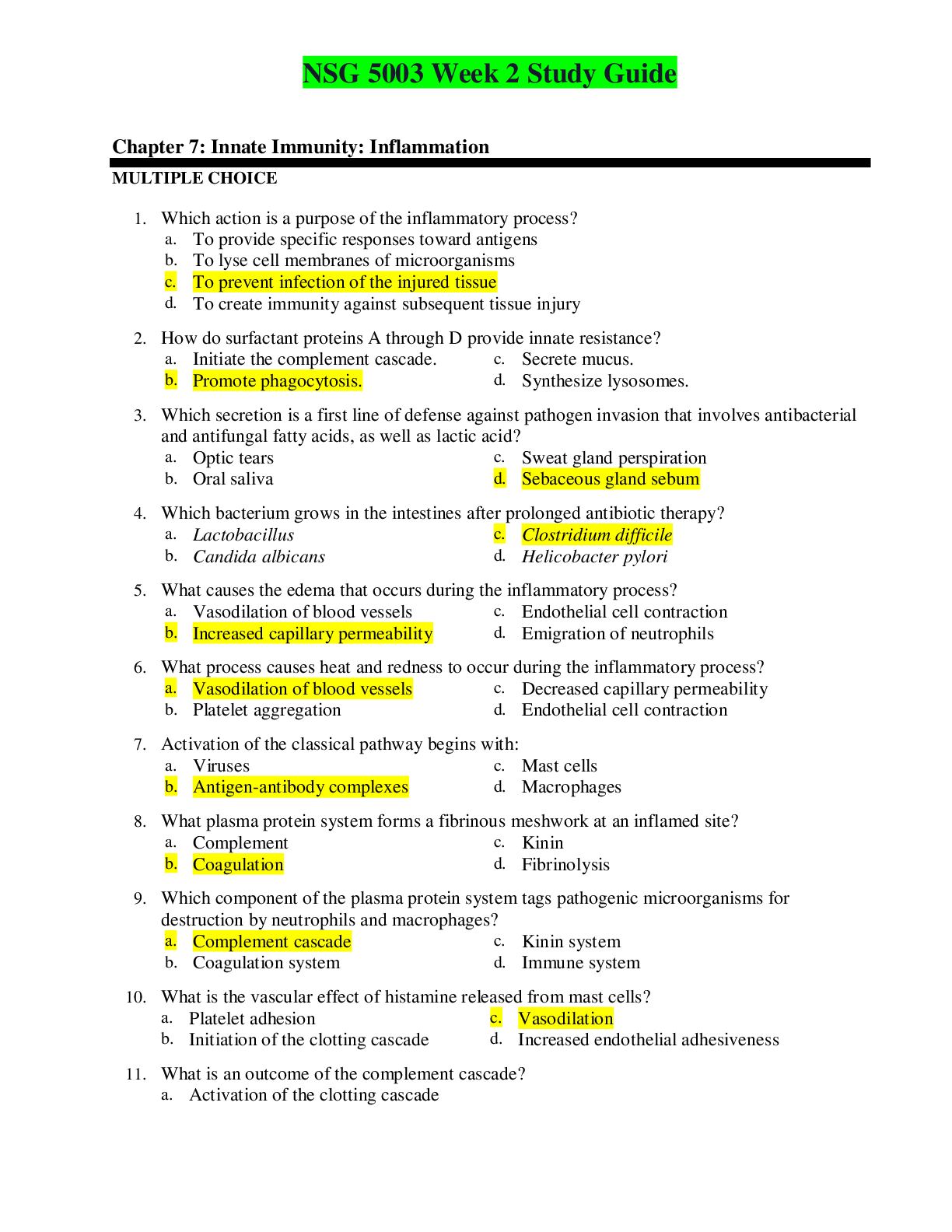
Buy this document to get the full access instantly
Instant Download Access after purchase
Buy NowInstant download
We Accept:

Also available in bundle (1)

NSG 5003 STUDY GUIDES
Week 4 Study Guide - Chapter 30 -32| Week 9 Study Guide - Chapter 15, 17 -20|Week 2 Study Guide - Chapter 7 - 11|Study Guide - Chapter 1, 2 & 3| Week 6 Study Guide - Chapter 27 - 30|Week 8 Study Guide...
By Ajay25 4 years ago
$42
7
Reviews( 0 )
$15.00
Can't find what you want? Try our AI powered Search
Document information
Connected school, study & course
About the document
Uploaded On
Feb 18, 2021
Number of pages
18
Written in
Additional information
This document has been written for:
Uploaded
Feb 18, 2021
Downloads
0
Views
190


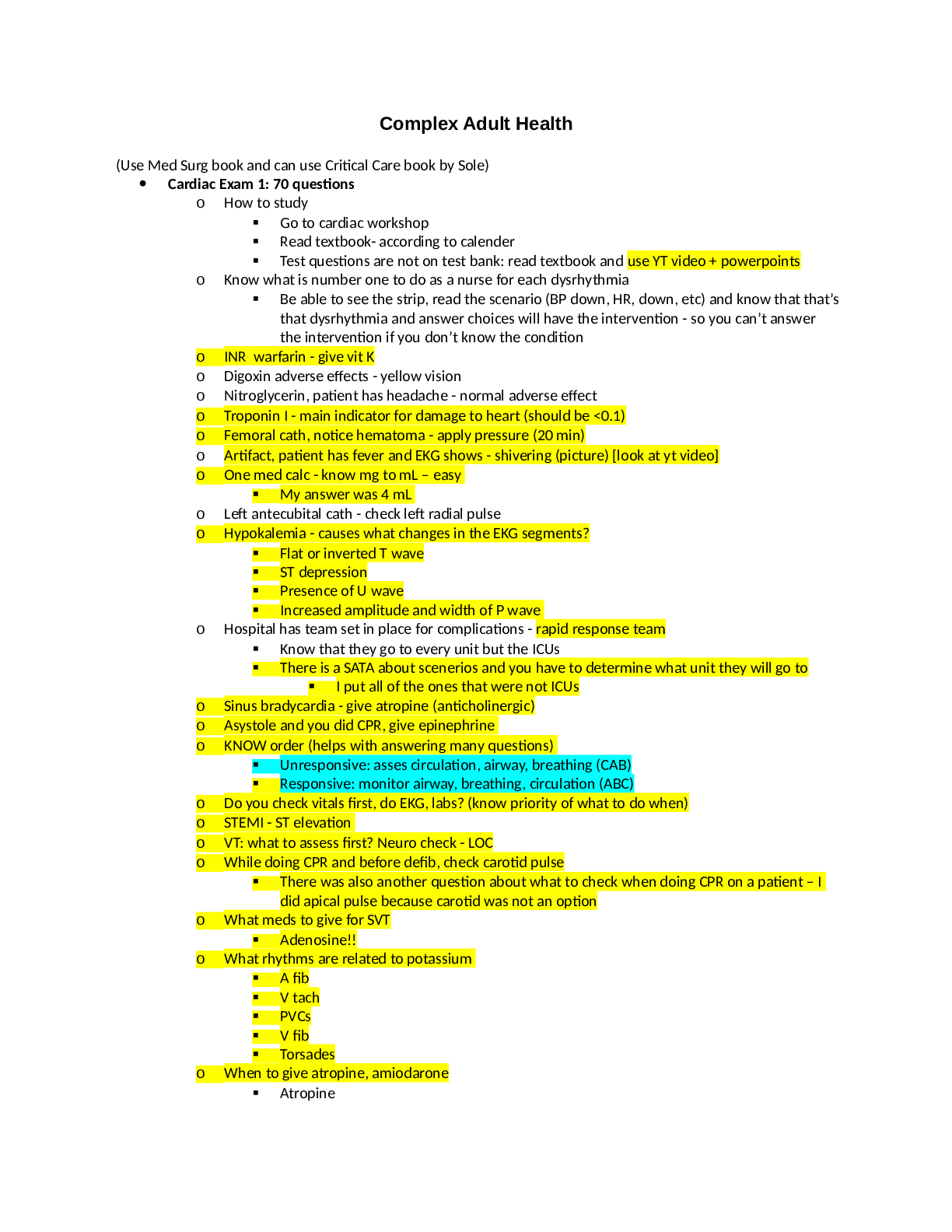
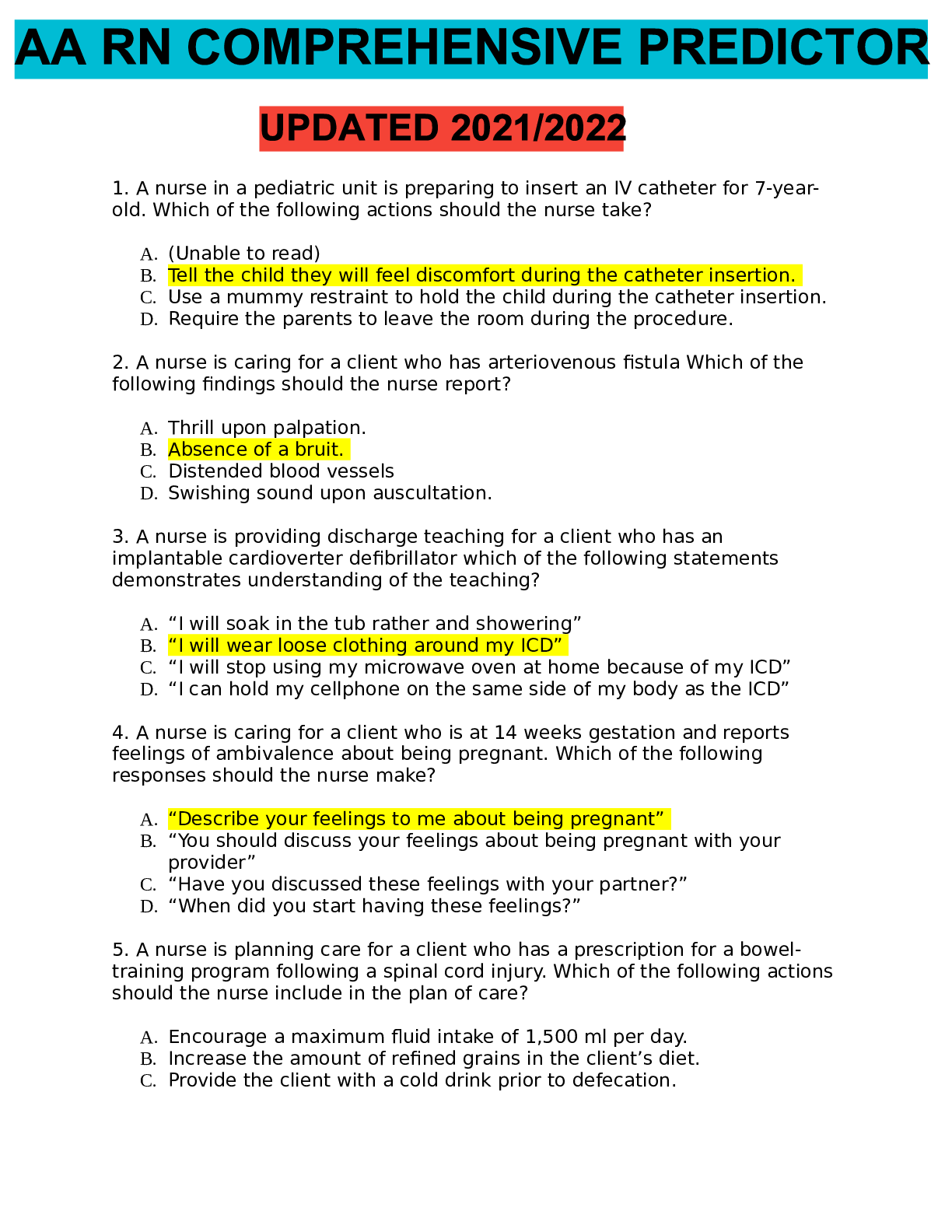
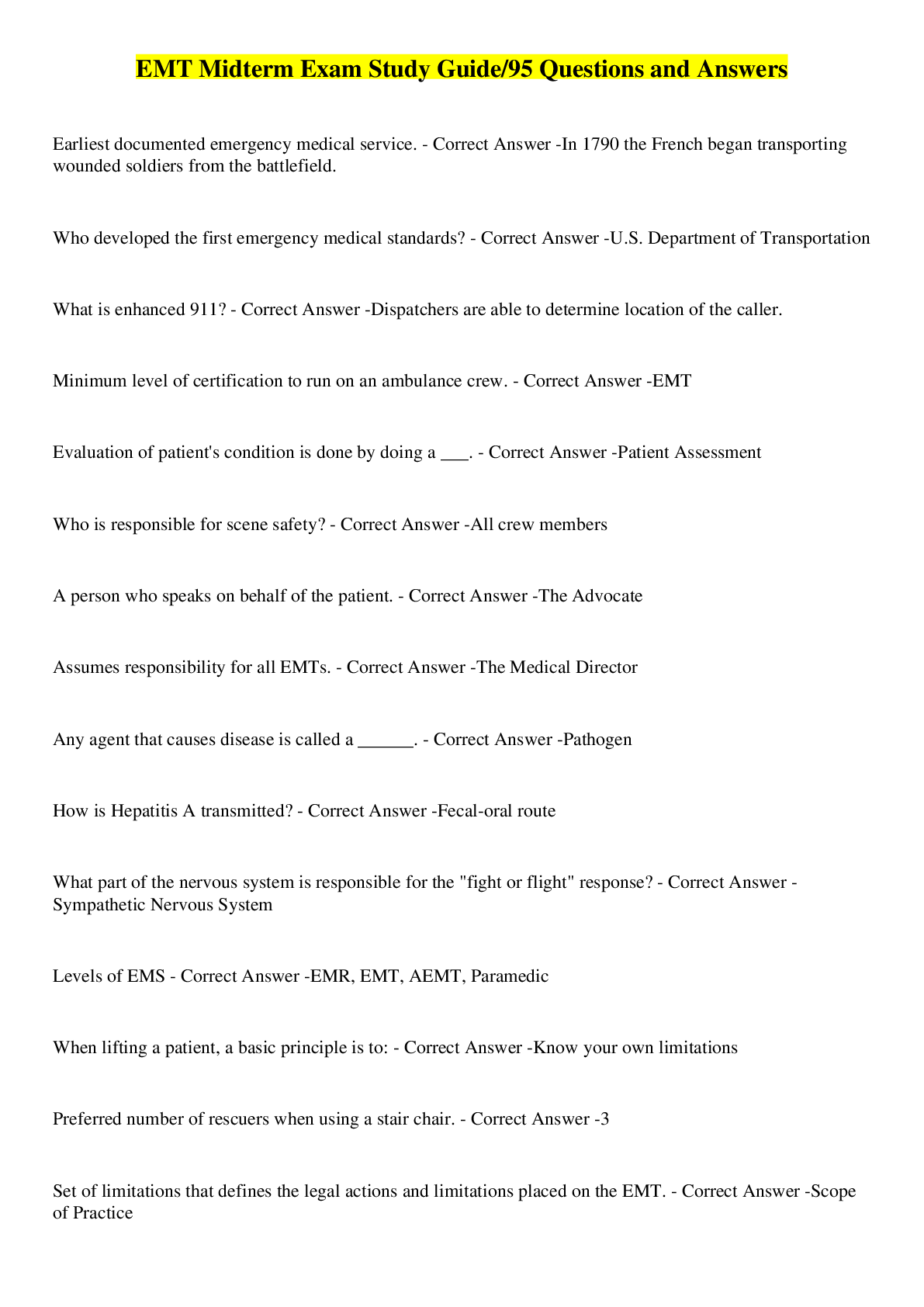
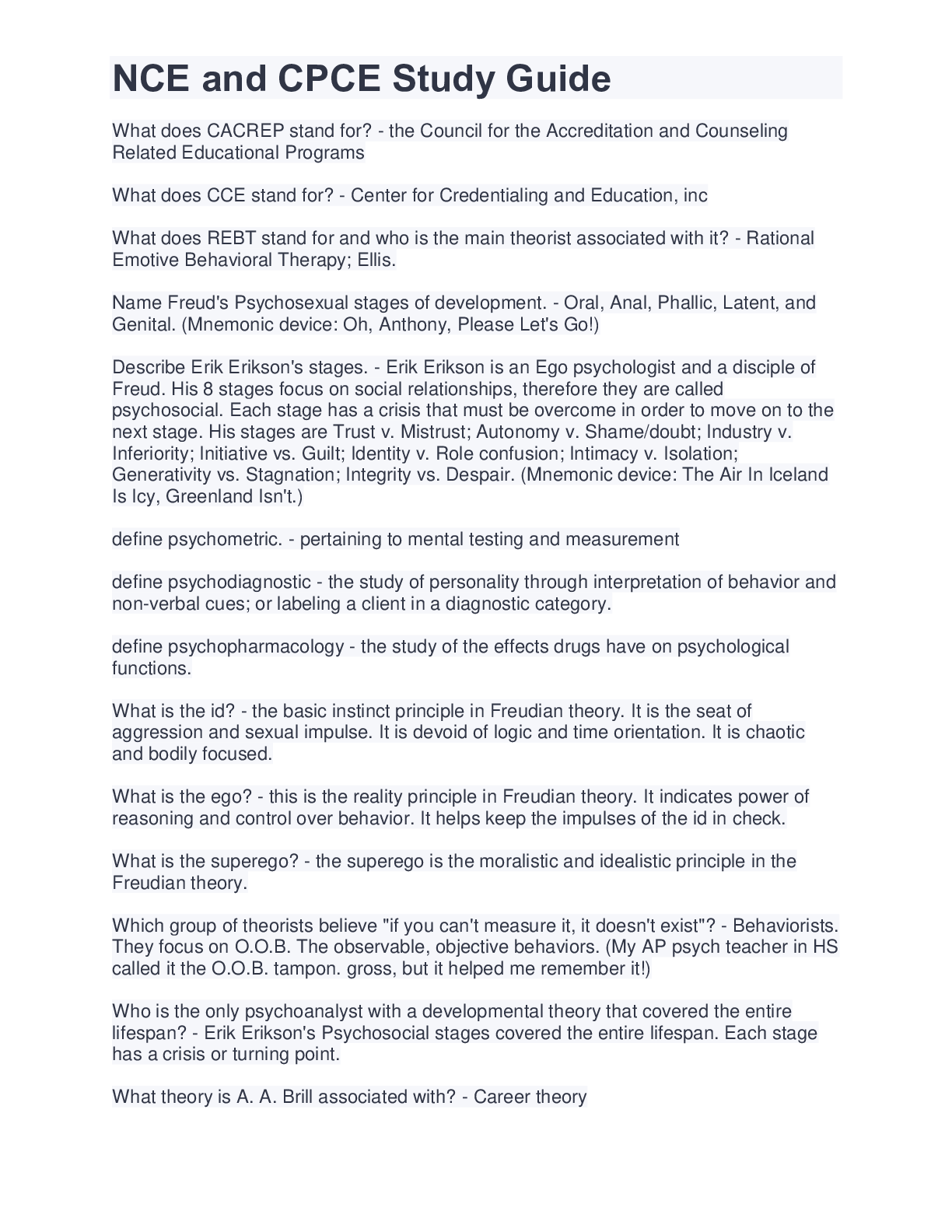
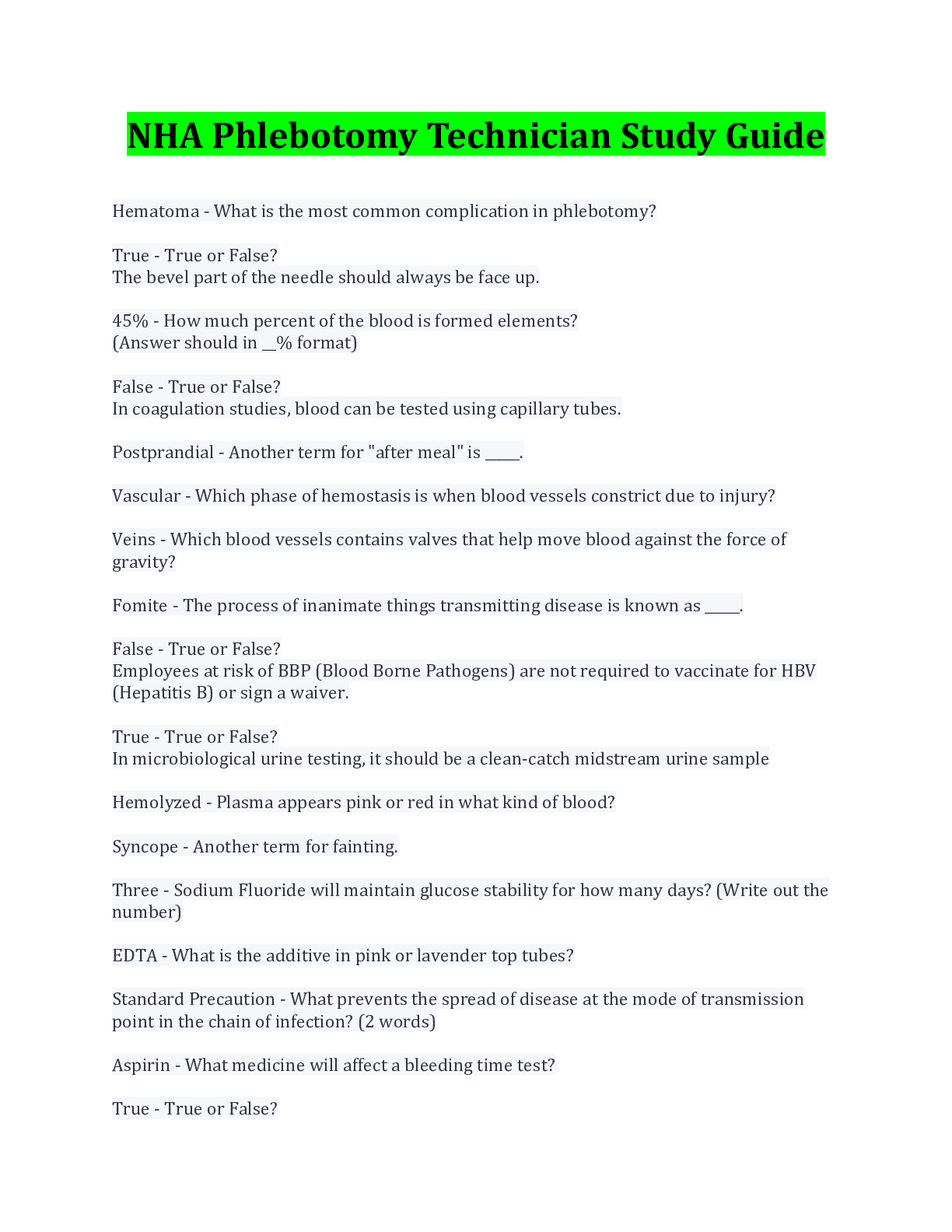
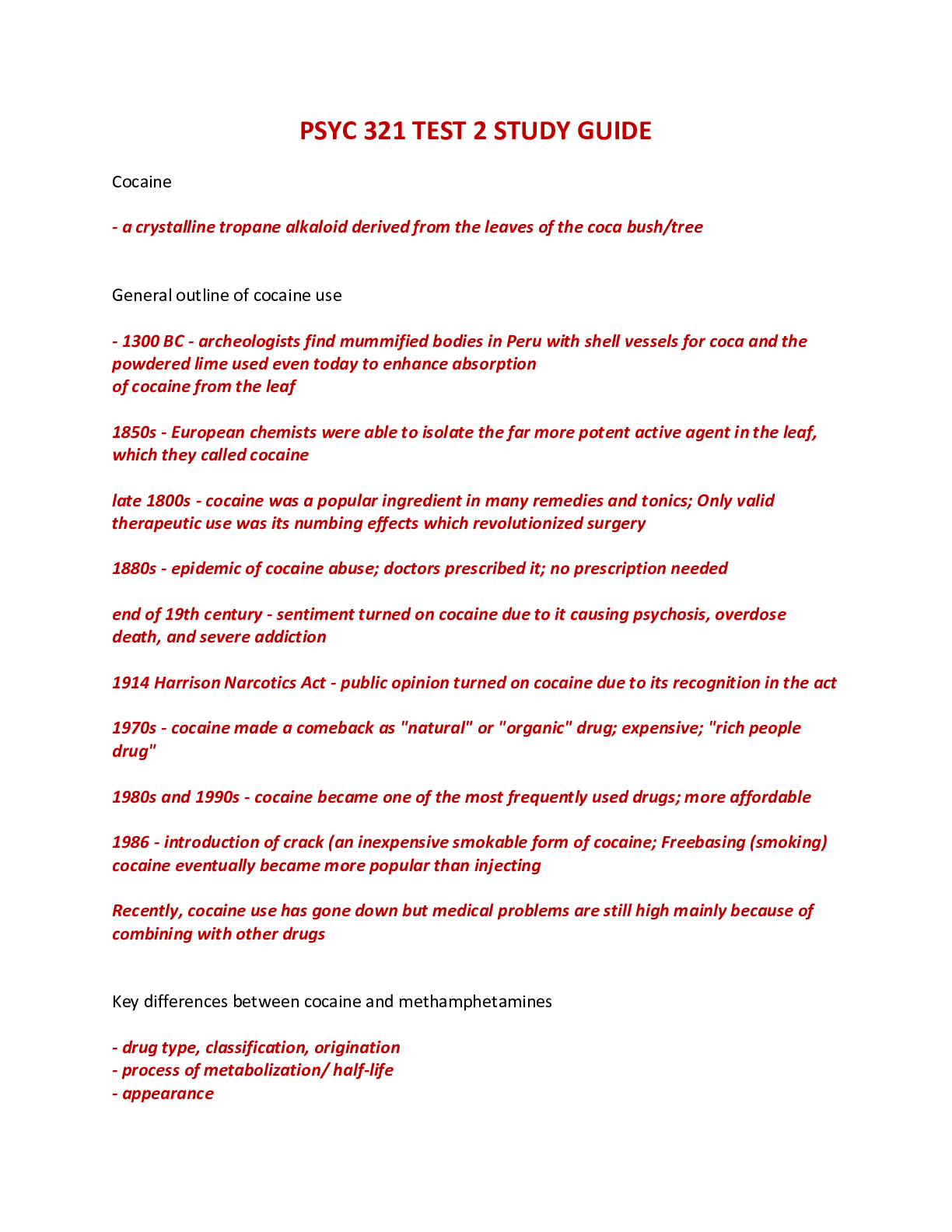
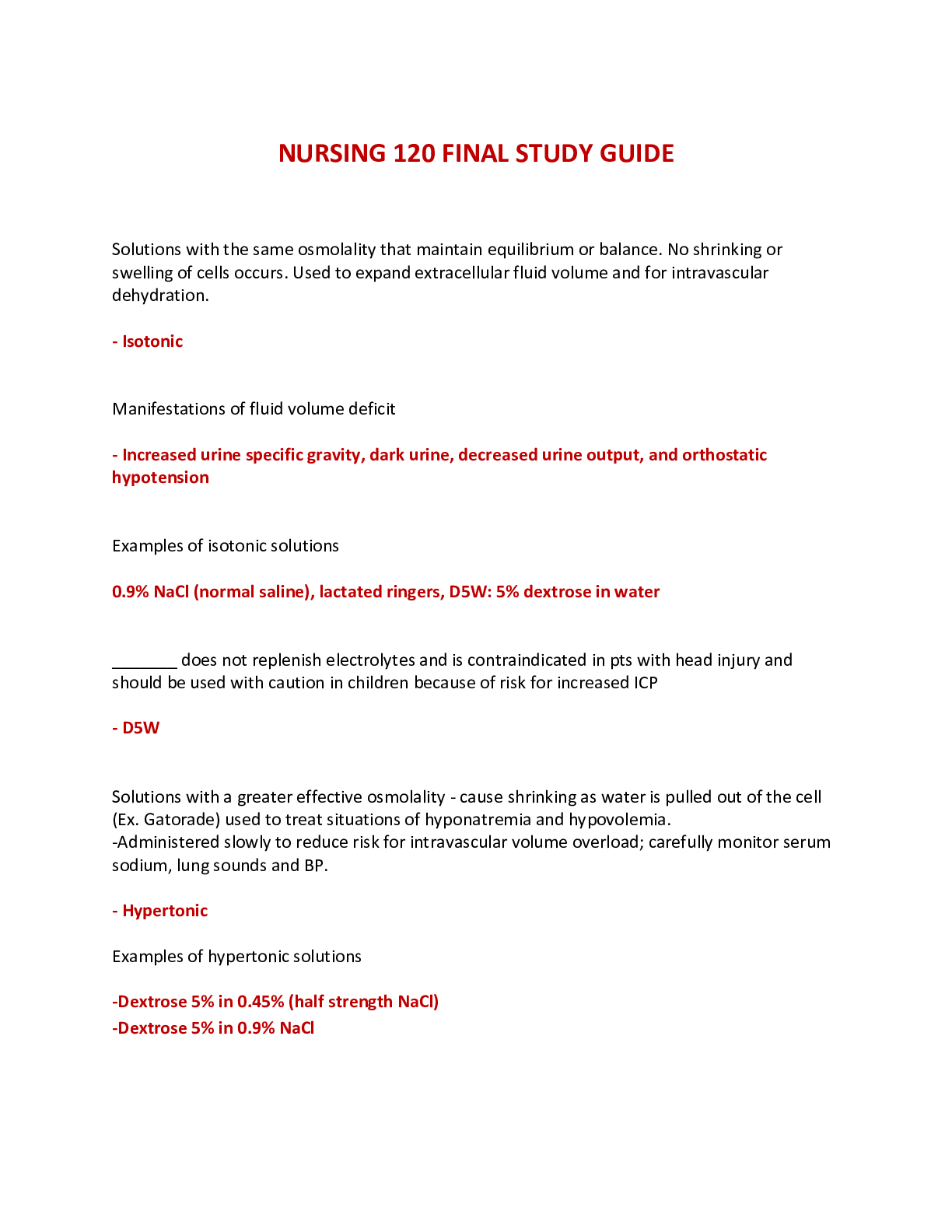



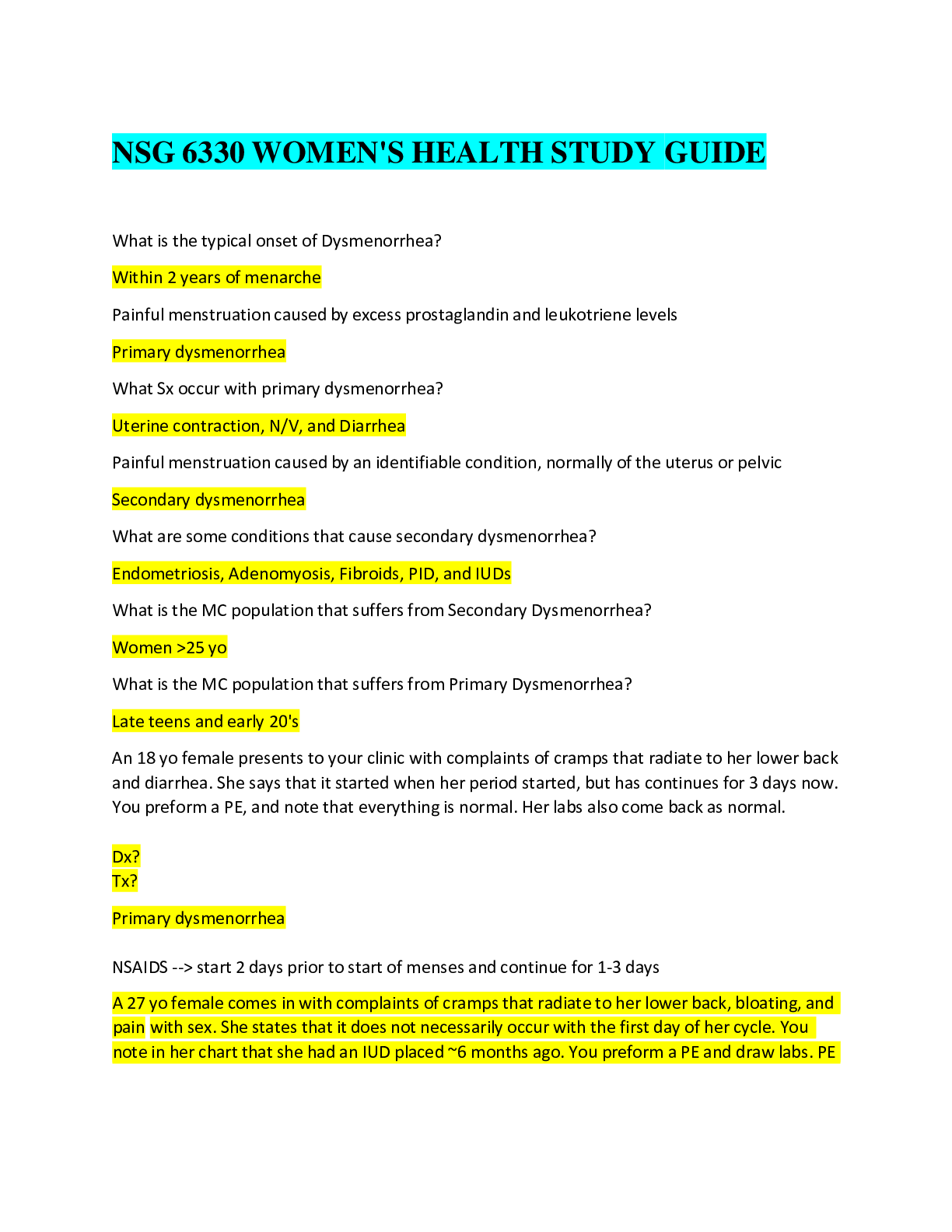
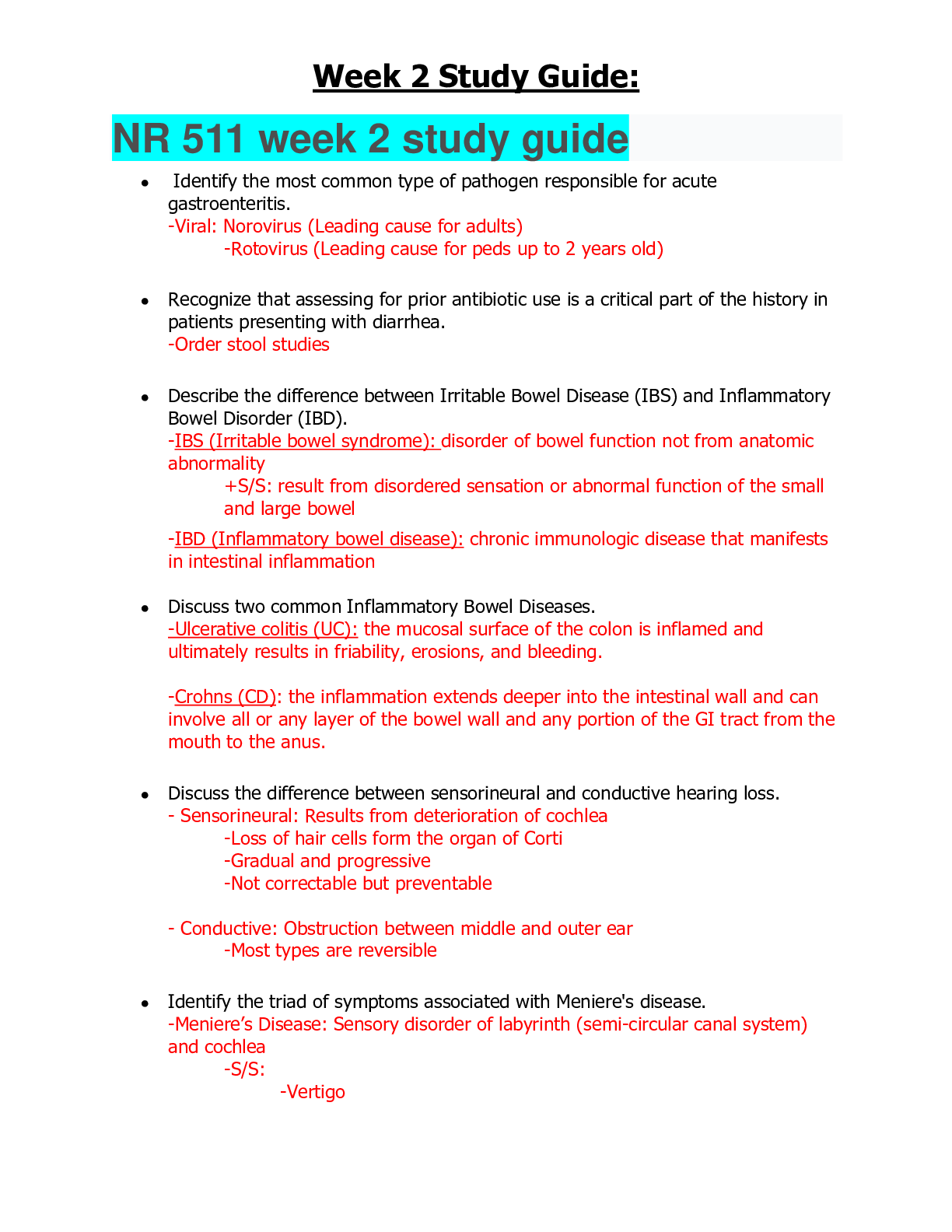
 qans.png)

.png)






